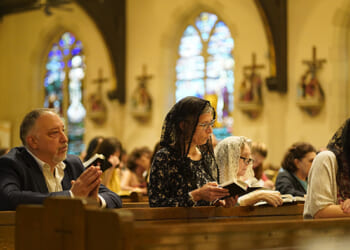The first moment we encounter Mary in the Gospel is when she is visited by the archangel, Gabriel, in Nazareth, where he announced that she would conceive and bear the Incarnate Son of God to the world. Ultimately, her response was, “Behold I am the servant of the Lord; let it be done to me according to your word” (Lk. 1:26-38). This is known as her fiat, Latin for “let it be.”
This spoken word is the best known fiat of her life, as very few of Mary’s words are recorded in the Gospels. Still, there are other moments throughout her life, during Jesus’ public ministry and Paschal Mystery, when her presence or reaction imply a trustful acceptance of God’s will—a fiat. Examining these fiat moments can help us find the humility and courage to utter our own fiats, learning to place ourselves in the Lord’s service, even if the idea of surrender can be frightening.
The first implicit fiat took place shortly after the Annunciation, before Jesus had yet been born. When Mary was far advanced in pregnancy, she was required by decree of the Roman emperor to trek with her husband, Joseph, to Bethlehem. She was uncomfortable, probably even a little anxious (just on a natural level). Anyone who has traveled with a woman in the late stages of pregnancy knows it is not easy or pleasant for her. Likewise, when they reached Bethlehem, they found no suitable lodging, likely because they were unwelcome among Joseph’s family. At last, she was given a feeding stable for animals where she could give birth and convalesce. Surely, these were pivotal moments when she had to pray again, “Let it be done to me according to your word, Lord.” Fiat.
After Jesus was born into this world, Mary and Joseph presented Him in the Temple, “according to the Law of Moses” (Lk. 2:22-38). In that moment, the “righteous and devout” Simeon declared that this Baby would be “a sign which men will refuse to acknowledge” (v. 34, Knox translation); and that His mother would have her heart pierced by a sword also (v. 35). What mother would not recoil at the idea of her child being rejected, and at the forecast of her own suffering because of His rejection? Yet, Mary knew that she was only a steward of this Child, and that the fulfillment of His purpose would include sorrow and suffering. Fiat.
That sorrow and suffering was identified again at the Epiphany. Magi from the eastern empires brought gifts to the newborn Messiah (Mt. 2:11). Gold surely would have been nice, and the frankincense probably would have masked the stable’s stench. But myrrh, an oil for anointing sick or dead bodies? How could this be related to the newborn Son of God? Mary must have realized, or re-accepted, at this point that the God-Man was born to suffer and die. This was her opportunity to accept God’s will, His plan, with extraordinary trust. Fiat.
Another situation not long after the Magi’s visit could have led to discouragement or fear. Joseph told Mary that he had been warned in a dream of danger to the Child’s life. Therefore, the young family had to travel to Egypt, an unknown land some significant distance away (somewhere around 350 miles at minimum), for an unknown duration of time (Mt. 2:13). We can intuit that traversing a desert and establishing a temporary home, all while worrying that her Son would be killed by a diabolical king, would challenge even the humblest, most trusting of mothers. Fiat.
Years later, Mary and Joseph would bring Jesus back to Jerusalem for the highest of Jewish solemnities, the Feast of the Passover (Lk. 2:41-50). After the festival, they lost Jesus for three days. It is easy to imagine Mary praying throughout that time that God’s will, His word, would be manifest here. When the parents found Jesus at the Temple, “they did not understand the saying that [Jesus] spoke to them” (v. 50). Despite not fully understanding why the young Lord had acted or spoken as He had, Mary “kept in her heart the memory of all this” while they lived in Nazareth, pondering what all this meant (v. 51, Knox translation). This must have been a time for Mary to recognize that she would never be able to cross the infinite chasm between her understanding and God’s ways without His initiative and help. Fiat.
Nearly two decades later, as a young man of roughly thirty years old, Jesus waited on Mary’s initiative to begin His public ministry. At a wedding feast in Cana (Jn. 2:1-5), Mary pointed out to Jesus that the celebration had run out of wine. If Jesus consented to her request to assist the couple in awkward distress, it would signal the beginning of His public ministry. In Jesus’ question to her, she knew that “her relations with Him would be henceforth changed,” as Ven. Fulton Sheen has written. After He was “launched on the work of Redemption, she would no longer be just His mother, but also the mother of all His human brethren whom He would redeem” (Life of Christ, 2008, 90). Any loving mother probably struggles to overcome her own selfish desire to keep a beloved child close to her breast, protecting him from the trouble and harshness of everyday life and work. Fiat.
Some of that trouble and harshness showed itself while Jesus conducted His public ministry. In Galilee, people surely knew Mary and remarked about the ways her Son was challenging the Jewish culture of the day. Yet, her intervention at Cana meant that she had to accept this development. In one moment, while Jesus was teaching, members of the crowd announced that His mother and other male relatives were outside the house waiting to see Him. Jesus’ reply was that “whoever does the will of God, he is my brother and sister and mother” (Mk. 3:31-34). Within the ancient Jewish cultural context, this could have been taken as a rejection of the most sacred familial bond, that of a mother and son. Yet again, Mary knew that she had only been called as a vessel and a steward. Fiat.
Later, also in Galilee, Jesus taught in a synagogue on a Sabbath. The community “took offense at him.” Beyond that, the text tells us that “he could do no mighty work there . . . because of their unbelief” (Mk. 6:1-6). Surely, Mary had come to know and support Jesus’ mission of proclamation leading to salvation. Thus, this moment of rejection needed to be met with trust that the Divine Mind and Will had a fuller vision of how the salvation of the world would be accomplished. Following that moment, Mary had to believe that God’s purpose could not be thwarted. Fiat.
Finally, at multiple points during the Paschal Mystery, Mary opened her heart and offered herself again as “the handmaid of the Lord.” When she came to know of Jesus’ death sentence, she must have been tempted to wrest control and do whatever she could to liberate Him. Her acceptance of the Father’s will in this moment, as in all the prior moments, was identical with Jesus’ prayer in the Garden of Gethsemane: “not my will, but yours [Father], be done” (Lk. 22:42). Later that day, while Jesus hung on the Cross, the Lord gave the beloved disciple into Mary’s motherly care: “Woman, behold your son.” From that moment, she went to reside with a new son, spiritually adopted (Jn. 19:26-27). Finally, when the apostles and other disciples waited in Jerusalem for the promised Holy Spirit, Mary engaged in the original novena with them. These moments solidified her role as Mother of the Church, one who could protect and nurture all disciples in their effort to extend Jesus’ ministry of salvation. Even in seeing God’s plan fulfilled, she came to know more specifically that she could serve in a particular way. Fiat.
Considering these moments and movements, pondering the passions and emotions Mary probably felt, allows us to connect with her on a deeper level, which is something Jesus wants. After all, He told His beloved disciple, who stands as a symbol for each of us, “Behold, your mother!” Deepening our connection with her, then, will allow us to accept in trustful surrender what the Lord presents to us at various moments in our lives, whether pivotal or mundane. Fiat!
Image from Wikimedia Commons

















